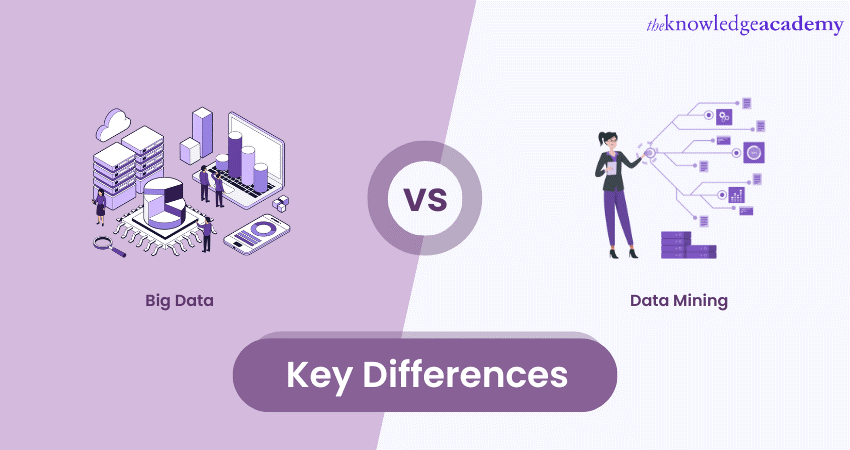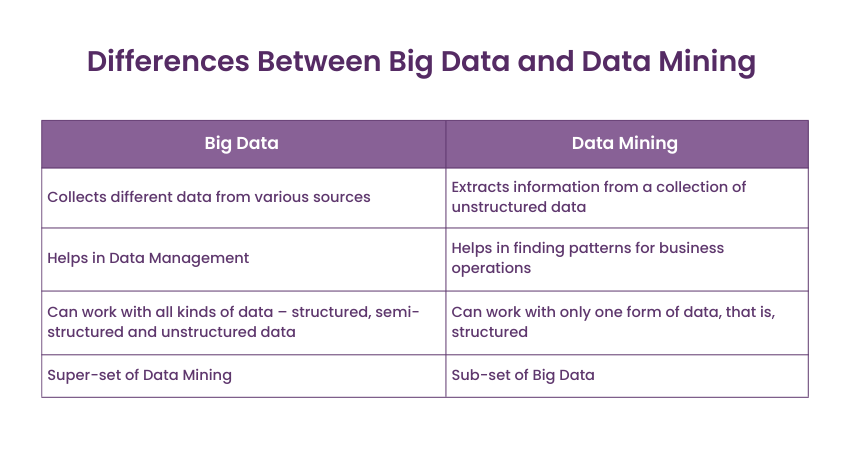We may not have the course you’re looking for. If you enquire or give us a call on 01344203999 and speak to our training experts, we may still be able to help with your training requirements.
Training Outcomes Within Your Budget!
We ensure quality, budget-alignment, and timely delivery by our expert instructors.

Big Data vs Data Mining is a fascinating topic that delves into the heart of modern Data Analysis. Big Data denotes the enormous volumes of data generated every second, from social media posts to transaction records. But how do we make sense of this overwhelming information? That’s where Data Mining comes in, the process of extracting valuable patterns and insights from these massive datasets.
In this blog, we’ll explore the dynamic relationship between Big Data vs Data Mining. Additionally, with Statista predicting a rise in IoT-connected devices by 2025, understanding how they transform raw data into actionable intelligence is crucial. So, let’s dive in and uncover their secrets.
Table of Contents
1) What is Big Data?
2) What is Data Mining?
3) Differences Between Big Data and Data Mining
4) Does Big Data Collect or Choose Data?
5) Which is Better, Big Data or Data Mining?
6) Conclusion
What is Big Data?
Before you learn the differences between Big Data vs Data Mining, let us first know what Big Data is. As there have been many technological advancements, the amount of data that is generated has increased considerably. Big Data is related to vast datasets, which can be categorised into structured, semi-structured and unstructured data. These large and complex datasets cannot be stored, analysed or processed by regular data processing tools.
Big Data is categorised into 5Vs. These are as follows:
a) Volume: It refers to the enormous amount of data that is collected from various technological tools and devices.
b) Variety: It refers to the types of data that are collected.
c) Velocity: The speed at which data is increasing every day is referred to as the velocity in Big Data. To analyse this data swiftly, Big Data technologies are used.
d) Veracity: It refers to the data that is accurate and reliable. Big Data is often used to make strategic planning and decision-making based on the accuracy of the data collected and analysed.
e) Value: Value in Big Data is defined as the way data is collected, stored, processed and analysed.
What is Data Mining?
Now, let's understand what Data Mining is in detail. Data Mining is defined as the process of extracting information from a large amount of data and analysing it. It also helps in establishing certain patterns within the data. It is also known as Knowledge Discovery in Databases (KDD). Data Mining uses advanced techniques to find useful information in these datasets.
Data Scientists mainly use Data Mining to analyse business operations in an organisation. This process of extracting data involves four stages:
a) Gathering Data: Before extracting data, all the relevant data is identified and collected. The types of data that are generated from various sources are assembled in a data lake or data warehouse. From this warehouse, the following steps are carried out.
b) Preparing the Data: Unfiltered and raw data are seldom analysed by Data Scientists. To begin the process of Mining, the data collected are filtered – then they are explored, pre-processed, categorised, and profiled.
c) Mining the Data: After the Data Scientist makes the data ready for the mining process, they implement the particular mining technique that is required for that dataset. If Data Scientists use Machine Learning for Data Mining, they train the algorithms on sample datasets which are familiar with the data that will be mined.
d) Analysing the Data: Data Mining is done to create some analytical decisions before making any critical business decisions. This analysis helps to communicate any future patterns or trends that may influence the business operations.
Gain the expertise to uncover trends and patterns in complex datasets – join our Data Mining Training now!
Differences Between Big Data and Data Mining
Big Data and Data Mining are both critical for the analysis of data to help organisations perform business operations. Here are some differences between them:

Definition
Big Data Integration can be defined with the help of 5Vs, which determines the quantity of the data, the type of data, the flow of the data, the availability of data and most importantly, the quality of data.
On the other hand, Data Mining is a process which extracts information from the data collected. With this information extracted, it is able to provide patterns and trends to help business operations predict future market trends and maximise their profits.
Sign up for our Advanced Data Analytics Course and gain the expertise to drive data-driven decisions.
Importance
Big Data plays an important role in helping business operations streamline their operations. Not only do they collect data from various sources, but they also help in analysing the source so that there is enough credibility from which the data has been collected. It collects all the data, whether it is structured, semi-structured or unstructured and turns them into datasets. These datasets are then analysed.
Whereas Data Mining extracts information from the data collected. It does not analyse the source of the data but analyses the datasets. It uses programming language such as Machine Learning to identify patterns, behaviours, etc., which separates it from Big Data. The information which is extracted is done under certain circumstances with an objective in view.
Advantages
Here, we will discuss the advantages of Big Data and Data Mining.

Disadvantages
Let’s explore the disadvantages of Big Data and Data Mining in detail:

Does Big Data Collect or Choose Data?
Big Data involves both collecting and selecting data. Let’s explore them in detail:
1) Data Collection
This process gathers vast amounts of information from sources like social media, websites, and IoT sensors. The data can be unstructured, including text, images, and videos.
2) Data Selection
After collection, relevant data is chosen for analysis. This step filters out unnecessary information, ensuring only high-quality data is used.
3) Integration
Combining both processes allows organisations to derive actionable insights and make informed decisions. For example, a retail company might collect customer transaction data and then select relevant purchase history for analysis.
Which is Better, Big Data or Data Mining?
Determining whether Big Data or Data Mining is better depends on the context and specific needs of an organisation, as both play crucial roles in Data Analysis and decision-making. Let's compare them in detail:
1) Scope: Big Data encompasses the entire process of collecting, storing, and analysing large datasets, while Data Mining specifically focuses on extracting useful information from these datasets.
2) Tools and Techniques: Big Data requires advanced infrastructure and tools like Hadoop and Spark for processing, whereas Data Mining uses statistical and Machine Learning techniques to analyse data.
3) Applications: Big Data is used for a wide range of applications, including real-time analytics and predictive modelling, while Data Mining is more focused on discovering patterns and relationships within the data.
Conclusion
In conclusion, while Big Data vs Data Mining might seem like a battle, they complement each other. Big Data provides the vast ocean of information, while Data Mining is the treasure hunt that uncovers its hidden gems. By mastering both, you can transform raw data into valuable insights and drive smarter decisions.
Learn how to analyse data effectively and gain expertise in combining programming languages to solve complex problems – sign up for our Data Science Training.
Frequently Asked Questions

No, Big Data and Data Mining aren’t the same. Big Data refers to vast, complex data sets, while Data Mining involves analysing and extracting useful patterns from such data, often leveraging Big Data for insights.

An example of Big Data is social media platforms like Facebook. They generate massive amounts of data daily from user interactions, which can be analysed for patterns in user behaviour, preferences, and trends.

The Knowledge Academy takes global learning to new heights, offering over 30,000 online courses across 490+ locations in 220 countries. This expansive reach ensures accessibility and convenience for learners worldwide.
Alongside our diverse Online Course Catalogue, encompassing 19 major categories, we go the extra mile by providing a plethora of free educational Online Resources like News updates, Blogs, videos, webinars, and interview questions. Tailoring learning experiences further, professionals can maximise value with customisable Course Bundles of TKA.

The Knowledge Academy’s Knowledge Pass, a prepaid voucher, adds another layer of flexibility, allowing course bookings over a 12-month period. Join us on a journey where education knows no bounds.

The Knowledge Academy offers various Big Data and Analytics Trainings, including the Advanced Data Analytics Course, Big Data Analysis Course, and Data Science Analytics Course. These courses cater to different skill levels, providing comprehensive insights into a Data Pipeline Architecture.
Our Data, Analytics & AI Blogs cover a range of topics related to Big Data Analytics, offering valuable resources, best practices, and industry insights. Whether you are a beginner or looking to advance your Data Analytics and Artificial Intelligence (AI) skills, The Knowledge Academy's diverse courses and informative blogs have got you covered.
Upcoming Data, Analytics & AI Resources Batches & Dates
Date
 Hadoop Big Data Certification
Hadoop Big Data Certification
Thu 23rd Jan 2025
Thu 20th Mar 2025
Thu 22nd May 2025
Thu 17th Jul 2025
Thu 18th Sep 2025
Thu 20th Nov 2025







 Top Rated Course
Top Rated Course



 If you wish to make any changes to your course, please
If you wish to make any changes to your course, please


